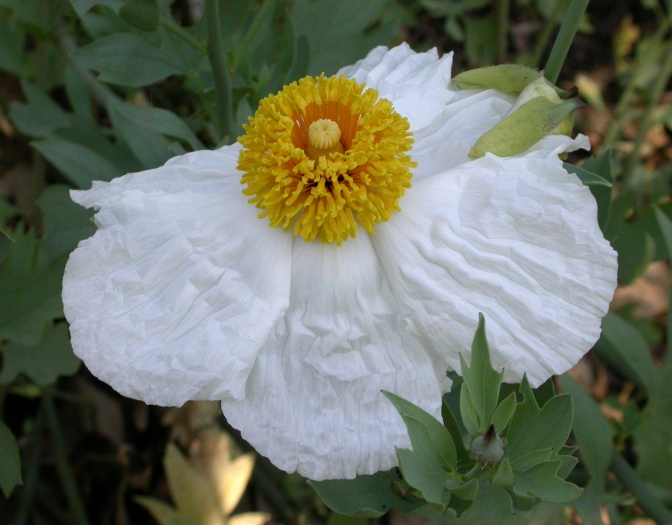Bristly Matilija Poppy
(Romneya trichocalyx)
Bristly Matilija Poppy (Romneya trichocalyx)
/
/

Curtis Clark assumed
CC BY-SA 2.5
Image By:
Curtis Clark assumed
Recorded By:
Copyright:
CC BY-SA 2.5
Copyright Notice:
Photo by: Curtis Clark assumed | License Type: CC BY-SA 2.5 | License URL: https://creativecommons.org/licenses/by-sa/2.5 | Uploader: Curtis Clark | Publisher: Wikimedia Commons | Title: Romneya_trichocalyx_flower_2003-04-10.jpg | Notes: == Summary == {{Information |Description=Rose Hybrid China 'Bengale Rouge' (Gaujard 1955) |Source=own |Date=2006 |Author=Ulf Eliasson [[User:Epibase|epibase]] |Permission= |other_versions= }} == Licensing == {{self|cc-by-sa-2.5}} |




















































Estimated Native Range
Summary
Romneya trichocalyx, commonly known as Bristly Matilija Poppy, is a semi-deciduous subshrub or shrub native to the coastal sage scrub and chaparral of Southern California and Baja California. It typically grows to 1 to 2.5 meters (3 ft 3 in to 8 ft 2 in) tall and is recognized for its large, showy white flowers that bloom from late spring to early summer. The gray-green leaves are dissected into lance-shaped lobes, contributing to the plant’s overall textured appearance. The inflorescence consists of a solitary flower with six white petals, each 4–8 centimeters (1.6–3.1 in) long, surrounding a center filled with numerous yellow stamens. The fruit is a bristly capsule containing many tiny seeds. Romneya trichocalyx spreads via a network of rhizomes, which can make it somewhat invasive in garden settings.
The Bristly Matilija Poppy is valued for its striking flowers, which are among the largest of any native California plant species, and its drought tolerance, making it suitable for xeriscaping. It is often used in naturalistic plantings, as a focal point in gardens, and for erosion control on slopes. This plant thrives in full sun and requires well-draining soil with low to moderate water once established. It is resistant to many pests and diseases but can be difficult to establish due to its preference for undisturbed soil and can spread aggressively if conditions are favorable.CC BY-SA 4.0
The Bristly Matilija Poppy is valued for its striking flowers, which are among the largest of any native California plant species, and its drought tolerance, making it suitable for xeriscaping. It is often used in naturalistic plantings, as a focal point in gardens, and for erosion control on slopes. This plant thrives in full sun and requires well-draining soil with low to moderate water once established. It is resistant to many pests and diseases but can be difficult to establish due to its preference for undisturbed soil and can spread aggressively if conditions are favorable.CC BY-SA 4.0
Plant Description
- Plant Type: Subshrub, Shrub
- Height: 3-6 feet
- Width: 3-6 feet
- Growth Rate: Rapid
- Flower Color: White
- Flowering Season: Spring, Summer
- Leaf Retention: Semi-Deciduous
Growth Requirements
- Sun: Full Sun
- Water: Low
- Drainage: Medium
Common Uses
Bee Garden, Butterfly Garden, Drought Tolerant, Showy Flowers
Natural Habitat
Coastal sage scrub and chaparral of Southern California and Baja California
Other Names
Common Names: Hairy Matilija Poppy
Scientific Names: , Romneya trichocalyx, Romneya coulteri var. trichocalyx, Romneya coulteri subsp. trichocalyx,
GBIF Accepted Name: Romneya trichocalyx Eastw.